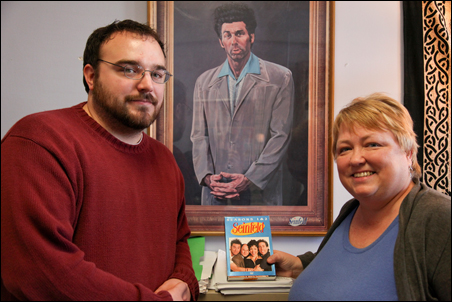Prof Proves Economics Can Be Funny -- Not That There's Anything Wrong With That
Nov-12-2010 George Lesica, assistant to the dean of the EIU College of Sciences, and Linda Ghent, chair of the EIU economics department, have collaborated with a former colleague to create "The Economics of Seinfeld," a website that shows how "Seinfeld" clips can be used to illustrate economic principles. George Lesica, assistant to the dean of the EIU College of Sciences, and Linda Ghent, chair of the EIU economics department, have collaborated with a former colleague to create "The Economics of Seinfeld," a website that shows how "Seinfeld" clips can be used to illustrate economic principles. |
For being about a show about nothing, an Eastern Illinois University professor's "Economics of Seinfeld" website sure is garnering a lot of attention.
The site -- www.YadaYadaYadaEcon.com -- describes how about 90 different "Seinfeld" clips can be used to illustrate economic principles. It is run by Linda S. Ghent, chair of the EIU economics department; George Lesica, assistant to the dean of the EIU College of Sciences; and Alan Grant, a former EIU economics faculty member who now teaches at Baker University.
"The Economics of Seinfeld" went online in the spring, but it was a talk Ghent gave at Berry College in October that started a media frenzy, after a professor there blogged about the site. The recent flurry of publicity -- including mentions on blogs on the New York Times, Wall Street Journal and The Economist, as well as a short news story in the print edition of the New York Daily News -- has brought the site as many as 30,000 page views per day.
"Once the word started spreading, it spread like wildfire," Ghent said. "We've been contacted by a literary agent, so now we're going to write a book."
Ghent teaches an honors section of an EIU senior seminar course called Pop Culture Economics, in which she uses clips from many TV shows, including "Grey's Anatomy," "House," "Boston Legal" and "King of Queens." But "Seinfeld" is by far her favorite sitcom to use in class.
"I think the episodes are timeless," Ghent said of the series that ran from 1989 to 1998. "The students all know the show still. There's no other show out there that has the cult following but also can last throughout the ages.
"It's kind of neat to be able to show students that economics is everywhere, and it's not dry and boring. It's about decision-making and life."
The most popular "Seinfeld" clip among students is from the "Soup Nazi" episode, in which a soup counter owner demands that his customers follow strict ordering rules if they want to have the privilege of buying his soup.
The website explains how the episode illustrates two economic principles, barriers to entry and monopoly power: "The Soup Nazi makes delicious soup -- so good there's always a line outside his shop. He refuses service to Elaine, and by a stroke of luck she comes across his stash of soup recipes. She visits his shop and informs him that his soup monopoly is broken, while waving his recipes in his face. Also in this clip, George gets charged $2 for a roll that everyone else gets for free. This example of price discrimination shows that in order to charge different customers different prices, you must have market power."
Another well-known episode, "The Bottle Deposit," illustrates arbitrage, fixed costs, incentives and variable costs: "Kramer and Newman hatch a scheme to arbitrage bottles from New York, where the deposit is 5 cents, to Michigan, where the deposit is 10 cents. They can't figure out how to make the costs work; gas is too expensive (variable costs), and there's too much overhead (fixed costs of tolls, permits, etc.) with using a semi to haul the bottles in volume. Finally, they hatch a scheme to use a mail truck, which lowers their variable and fixed costs to zero."
And the subject of tipping gets its due in "The Calzone," which addresses altruism, incentives and utility: "George puts a dollar in the tip jar at the pizzeria, but the counterman's head was turned and he didn't see it. George laments that it cost him a dollar, but he got no credit for it. His altruism is not pure -- he gets utility not from giving, but from getting credit for giving."
The clips spark discussion among students, which is the whole point, Ghent said.
"The students can see the real-life application very quickly," she said. "They serve as wonderful examples of the material we're teaching, and the students remember it when they leave. In fact, they start looking for economics whenever they watch TV, which is great."